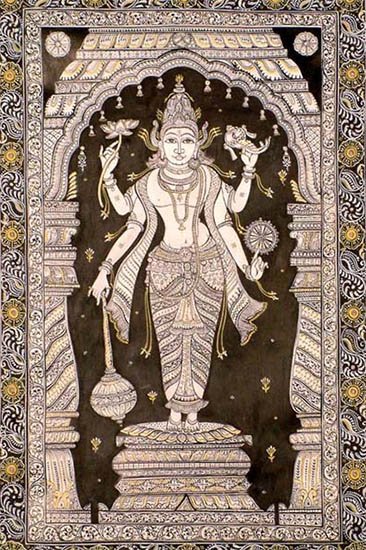Vyaktavyakta, Vyaktāvyakta, Vyakta-avyakta: 1 definition
Introduction:
Vyaktavyakta means something in Hinduism, Sanskrit. If you want to know the exact meaning, history, etymology or English translation of this term then check out the descriptions on this page. Add your comment or reference to a book if you want to contribute to this summary article.
In Hinduism
Shilpashastra (iconography)
Source: Shodhganga: The significance of the mūla-beras (śilpa)Vyaktāvyakta (व्यक्ताव्यक्त) refers to “images in manifest and non-manifest form” and represents a classification of Hindu images, as defined in the texts dealing with śilpa (arts and crafs), known as śilpaśāstras.—The images are again classified into vyakta or manifest form, vyaktāvyakta or manifest and non-manifest form, and avyakta or non-manifest form.

Shilpashastra (शिल्पशास्त्र, śilpaśāstra) represents the ancient Indian science (shastra) of creative arts (shilpa) such as sculpture, iconography and painting. Closely related to Vastushastra (architecture), they often share the same literature.
See also (Relevant definitions)
Partial matches: Vyakta, Avyakta.
Ends with: Avyaktavyakta.
Full-text: Viyattaviyattalinkam, Avyakta, Aruvuruvam, Vyakta, Isha.
Relevant text
Search found 10 books and stories containing Vyaktavyakta, Vyaktāvyakta, Vyakta-avyakta; (plurals include: Vyaktavyaktas, Vyaktāvyaktas, avyaktas). You can also click to the full overview containing English textual excerpts. Below are direct links for the most relevant articles:
The Matsya Purana (critical study) (by Kushal Kalita)
Part 2 - Main features of Sāṃkhya philosophy < [Chapter 5 - Philosophy in the Matsyapurāṇa]
The Linga Purana (by J. L. Shastri)
Chapter 15 - The form of the Supreme Lord < [Section 2 - Pūrvabhāga]
Chapter 98 - Thousand names of Śiva (Sahasranāma) < [Section 1 - Uttarabhāga]
Chapter 65 - Thousand names of Śiva (Rudra-sahasranāma) < [Section 1 - Uttarabhāga]
Lord Hayagriva in Sanskrit Literature (by Anindita Adhikari)
The Brahma Purana (by G. P. Bhatt)
Mahabharata (English) (by Kisari Mohan Ganguli)
Section III < [Aranyaka Parva]